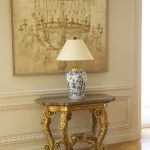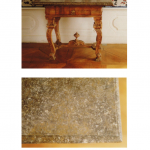8043 THE GIEBELSTADT TABLES – AN IMPOSING PAIR OF LATE BAROQUE GILTWOOD CONSOLE TABLES BEARING THEIR ORIGINAL FINE WÜRZBURGER GOLDBANK MARBLE TOPS Bamberg. Circa 1720. Measurements: Height: 32″ (81.5 cm) Width: 43″ (109.5 cm) Depth: 28″ (71 cm)

-
Figure 1
Research
Of giltwood with fine molded fossiliferous reef limestone (Würzburer Goldbank) top. Each with shaped marble top with molded edge and shaped undermold above a stepped and molded frieze raised on four scrolling uprights, each upright of undulating molded form with raised edging to the sides, set with acanthus carving to the top issuing trailing foliate carving, each upright issuing a scrolling foliate stretcher meeting at a restored central circular reserve supporting a molded dish, each upright terminating in a block foot with foliate carving.
Provenance:
Latterly at Stammschloss, Giebelstadt near Würzburg
The present tables are closely related to a console table which formed part of the original furnishings of Schloss Seehof, northern Bavaria, and which, according to correspondence from Dr. Alfred Schelter of Schloss Seehof,1 was probably made by the Bamberg based court furniture maker Servatius Brickard (1676-1742) in 1722 (figure 1). Originally from Brabant he moved to Bamberg in 1705 in ‘the service of Prince-Bishop Lothar Franz Von Schönbrun’ and in 1735 he was created Hofschreiner (cabinet maker to the court).
Both the Seehof table and the present pair are clearly infused with the same principles of design. The compact proportions of both are similar, as is the use of a distinctive compressed carved foot issuing from a scroll. Moreover, the tables also share a similarly flowing scrolling x-stretcher which unite to form a plateau while the legs on both are of restrained cabriole form.
The rare fossiliferous reef limestone tops are nearly identical in marking and coloration on all three tables and must have been cut from the same seam. This uncommon stone is known as “Würzburger Goldbank” and is mined locally.* Furthermore, both the top of the Seehof table and those of the present pieces have particularly fine beak molded edges and exaggeratedly overhanging tops, especially found in furniture made for the Prince-Bishops of Franconia. For example, a number of other tables with this same feature can be viewed in the entrance gallery of the Würzburg Residenz. With the above in mind, it seems possible that the present tables were also commissioned from Brickard for Seehof.
Seehof Palace was built from 1686 as a summer residence for the Bamberg Prince-Bishops by Prince-Bishop Marquand Sebastian Schenk von Stauffenburg, who commissioned the Würzburg architect Antonio Petrini. Stauffenburg was succeeded as Bishop of Bamberg in 1693 by Lothar Franz von Schönborn, who held the Bishopric until 1729 and would have been responsible for commissioning furniture for Seehof. As well as holding the seat of Bamberg, Lothar Franz was also Archbishop of Mainz (1695-1729), the highest in status of all the church dignitaries of the Holy Roman Empire.
Whilst presiding at Bamberg, Lothar Franz gained a reputation as a great patron of the arts, resuming the construction of the baroque building of the town’s New Residence, begun before the Thirty Years War, and commissioning the magnificent Pommersfelden Palace. It is within this context that the present tables can be seen as part of the aesthetic expression of the importance of the powerful and influential Prince-Bishops in the early 18th century.
Seehof ranks as one of Germany’s greatest houses, although sadly most of its vast contents were sporadically sold by its profligate owner in the 1950s. However, as a result of these sales, furniture with a Seehof provenance appears in a number of important collections, most notably the Metropolitan Museum of Art in New York. On display at the Metropolitan is the extraordinary set of seat furniture from Seehof, the backs of which are conceived as a trellis intertwined with vine leaves.
The present tables would presumably have left Seehof during this period of the 20th century, however, they did not travel far, as they latterly formed part of the dining room furniture of another noble house at Stammschloss, Giebelstadt, near Würzburg.
* We are grateful to Herr Walter Senger for this information.
Footnotes:
1. Schelter, Dr. Alfred. Letter to Carlton Hobbs. 27 Oct. 2003. Schloss Seehof, Memmelsdorf, Germany.






Comments are closed.